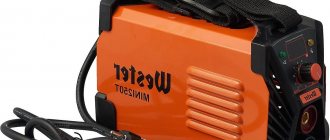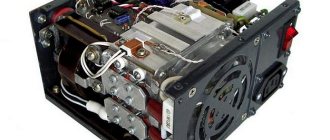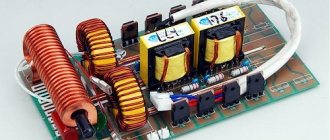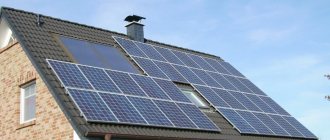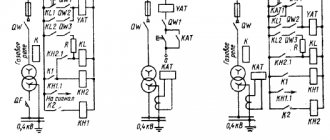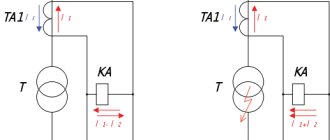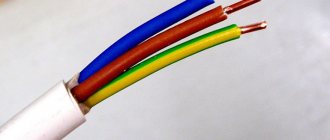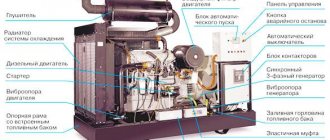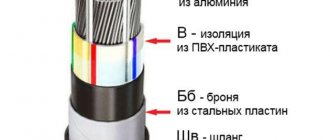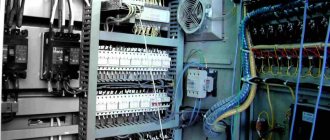How to make it yourself
If you know how to work with a soldering iron and have basic knowledge of electrical engineering and know how electronic devices work, you can make a voltage converter with your own hands.
Depending on the availability of radio components and the possibility of purchasing them, the circuits of the assembled inverter may be different. The easiest way to make a rectifier is based on a TLT494 PWM controller (the diagram is shown below):
With this configuration, the device, after assembly, will have the following technical characteristics: power - up to 0.3 kW, output signal - modified sine wave, output voltage - 220 V, frequency slightly higher than 50.0 Hz.
Using a pulse generator, which can be the KR1211EU1 microcircuit, you can also assemble a voltage converter. A similar diagram is shown below:
The power of an inverter assembled according to this scheme can reach 0.4 kW.
A 12/220 V converter with transistors is another option for making such a device yourself. A variant of the circuit, when using transistors, is shown in the following figure:
This circuit uses IRFZ44 transistors, which, if necessary, can be replaced with IRFZ40/46/48 or IRF3205/IRL3705, and TIP41 (KT819) transistors, which can also be replaced, if necessary, with KT805, KT815, KT817 and the like.
The assembled circuit (device) has the following characteristics: power - up to 0.3 kW, input voltage - 3.5-18 V, output voltage - 220 V, frequency 57 Hz, output pulse shape - rectangular.
The advantages of this scheme are: simplicity and the ability to assemble even for a person with basic knowledge and skills, low cost of components, compact dimensions of the circuit board and the device as a whole, the ability to replace components.
The disadvantages are: the circuit does not provide protection against short circuit currents, the efficiency is lower than that of factory-assembled products, and the transformer is noisy during operation.
Advantage of using voltage converters
Due to the fact that inverters have a number of positive characteristics, they are highly valued when used for various types of electrical equipment.
The devices operate silently and do not pollute the environment with all kinds of emissions. The cost of servicing such devices is minimal: there is no need to check the pressure in the engine. Inverters have fairly insignificant mechanical wear, which allows them to be used by various consumers. Inverters 12-220 V operate at increased powers KR121 EU and have increased efficiency. In the process of assembling inverters with master devices as multivibrators, the advantage of the converters is that the device is accessible and simple. The size of the products is compact, repairing them is not difficult, and they can be operated even at low temperatures.
Scheme and principle of operation of the inverter 12 220
The main part of radio components that use inverters use high frequencies in their operation. A pulse inverter completely replaces the classical circuit that uses transformers. The K561TM2 microcircuit is formed by two D-triggers, which have an R and S input. Such a microcircuit is created taking into account the use of CMOS technologies, by enclosing it in a plastic case.
The inverter master generators are mounted taking into account the K561TM2, using the DD1 device for operation. The DD1.2 trigger is mounted on the frequency divider. The amplification stages receive the signal from the microcircuits.
Generators with a sine wave for a 12-220 V inverter operate at high frequencies. To form a circuit with a size of 50 Hz, use a secondary winding with a parallel connection of capacitors and loads. By connecting any device, inverters create a conversion voltage of 220 V.
The circuit has one significant drawback - the imperfect form of the output parameters.
Speaking about how the 12 220 inverter works, it is worth pointing out that the K561TM2 chip is duplicated by the K564TM2. You can increase the power on the converter by selecting a more intense transistor
It is important to take into account the fact which capacitors are installed at the outputs. They have a voltage of 250 V
Welding rectifier - features of operation and assembly
To perform certain types of welding work, for example, with stainless steel, the use of alternating current supplied by a transformer is not used. To work with such metals, a constant voltage supply is required. In addition, direct current cutting reduces the consumption of electrodes, and metal spattering is prevented during welding.
To perform work in such conditions, welding rectifiers are used, which allow welding with direct and reverse polarity current. If you have experience in installing electronic circuits, then you can also assemble such a device yourself.
The basis of the welding rectifier will be the same step-down transformer. The difference lies in the presence of a rectifying electronic circuit. If desired, you can remake the already described welding transformer or assemble a universal device that will allow you to weld with both alternating and direct current.
The simplest diagram of the electronic part of a welding rectifier looks like this:
When assembling such devices, the following design features should be taken into account:
The main part of the device is a rectifier bridge made of powerful power diodes. They are connected according to the diagram, taking into account polarity. Smoothing of current ripple is carried out due to a filter made on the capacitor and choke coil
Please note that the components must have a margin of 2.5 - 3 permissible voltage. When working with high currents, the elements heat up. Semiconductor diodes are sensitive to overheating
Therefore, they are installed on radiators, which will increase the intensity of heat removal. When enclosing the device in a housing, it becomes mandatory to use a fan to increase cooling efficiency.
We pay attention to the connection of individual elements of the circuit. Considering that they will be exposed to high current, it is necessary to ensure reliable contact
If this is not done, then the wires in these areas will heat up and burn out. The preferred option is with fastening using platforms with a bolt and nut.
The choke in such designs is made in the form of a separate remote inductor, which is connected as needed. Note that installing a rectifier does not prevent the welding current from changing using the secondary winding coil position regulator.
As you can see, there are no difficulties in assembling a welding machine yourself. But it’s worth working on such devices only if you have experience in designing simple devices that operate with lower currents. Otherwise, entrust the assembly to a specialist or buy a factory welding machine.
Microwave welding machine:
Simple inverter 12-220 to 400 watts, diagram
Today I will show you the process of building a compact 12 to 220 volt converter with output voltage stabilization. I’ll say right away that this converter produces a constant voltage at the output; you can connect everything to it except devices containing network iron transformers or an AC motor.
Our converter can provide an output power of 120 watts, although if desired, with some modifications you can get up to 400 watts, I’ll tell you about that.
Among the shortcomings; There is no protection against short circuits, so it is worth adding fuses to the input and output. Perhaps in the future I will finalize the circuit and add electronic protection here.
Now about the design;
This is a step-up push-pull DC-DC converter, based on the SG3525 PWM controller. Unlike the good old TL494, this chip has a powerful output and is capable of controlling field-effect transistors with a large gate capacitance without an additional driver.
The outputs of the microcircuit are loaded with gates of field switches, the keys, in turn, control the pulse transformer, the feedback voltage is organized on a pair of zener diodes and an optocoupler, the zener diodes set the desired value of the output voltage,
An optocoupler - in my case, any one was torn out of a computer power supply,
On the body of such optocouplers there is a key in the form of a dot; it is also drawn on the printed circuit board so that beginners do not confuse the connections.
The field-effect transistors in this sample are IFRZ44, although more powerful ones are possible. The keys are installed on a common radiator, and they must be isolated from the radiator using mica gaskets.
There is also an indicator LED and a reverse polarity protection function; this function is organized on the basis of an ordinary diode, which simply locks in case you reverse the polarity of the power supply.
Transformer... - its winding data;
This option uses a core from a computer power supply with a real overall power of no more than 130 watts.
The primary winding is wound with a bundle of 4 wires of 0.6 millimeters each, with five centuries in each arm.
On top I put insulation from heat-resistant tape. The secondary winding is wound with a 0.5 mm wire containing 105 turns, and I also put insulation every 30 turns.
The output part uses a full-wave rectifier based on FR107 pulse diodes; any pulse or high-speed diodes with a current of at least 1 Ampere and a reverse voltage of at least 400 volts are suitable.
A correctly assembled inverter requires almost no adjustment; before assembly, you need to check all components for functionality.
Before soldering the transformer, it is worth checking for the presence of pulses on the gates of the field switches, only after that the pulse transformer is connected.
The no-load current is only 50-60 mA, which is very good even for such a small inverter. All this thanks to feedback and control buses.
The minimum supply voltage is 8-9 volts, therefore such an inverter can greatly discharge your battery, so I advise you to monitor the voltage on the latter or add a simple low-voltage protection function to the circuit.
To increase the output power, you need to replace the field switches with more powerful ones, say, IRF3205, add a second pair, replace the power transformer, also the output rectifier, electrolytic capacitor and, of course, the fuse. As a result, the diagram will look like this.
With this situation, the inverter can develop a power of 300-400 watts.
The board is in lay format. download…
Review of popular hybrid converters
Among consumers, inverters from foreign companies received good reviews: Xtender (Switzerland), Prosolar (China), Victor Energy (Holland), SMA (Germany) and Xantrex (Canada). Domestic representative - MAP Sine.
Xtender range of multifunctional inverters
The Studer hybrid converter from Xtender is the embodiment of the Swiss quality standard in power electronics. The Xtender series solar inverters are distinguished by their impressive strength characteristics and extensive functionality.
Variety of models: XTS - low-power representatives, XTM - medium-power models, XTN - high-power inverters.
Xtender power ranges: XTS - 0.9-1.4 kW, XTM - 1.5-4 kW, XTN - 3-8 kW. Output voltage – 230 W, frequency – 50 Hz
Each Xtender Hybrid Series offers the following features and options:
- pure sine wave feed;
- “addition” of power to the network from the battery;
- when the mains voltage decreases, consumption from the central power supply is reduced;
- two priority selection modes: the first is “soft” with power supply within 10%, the second is a complete switch to the battery;
- variety of installer settings;
- management of the backup generator;
- standby mode with a wide control range;
- remote monitoring of system parameters.
All modifications have the Smart Boost function - connection to different power suppliers (generator set, network inverter) and Power Shaving - guaranteed coverage of peak loads.
Optimal Prosolar Hybrid converters
The Chinese-made model has good characteristics and an acceptable cost (about 1200 USD). The converter optimizes the operation of solar panels by storing unused energy in the battery.
Technical characteristics: voltage form - sinusoid, conversion efficiency - 90%, installation weight - 15.5 kg, permissible humidity - 90% without condensation, temperature -25 ° C - +60 ° C
Distinctive features:
- option to track the limiting power point of a solar battery;
- information LCD display displaying operating parameters of the system;
- 3-level battery charger;
- maximum current adjustment up to 25A;
- inverter communication.
The converter is connected to a PC via software (supplied as a kit). It is possible to modernize the inverter through innovative flashing.
Sine wave inverters Phoenix Inverter
Phoenix inverters meet high demands and are suitable for industrial applications. The Phoenix Inverter series is released without a built-in charger.
The converters are equipped with the VE.Bus information bus and allow operation in parallel or three-phase configurations.
The power range of the model range is 1.2-5 kW, efficiency is 95%, voltage type is sinusoid.
The table shows the characteristics of the hybrid modification of the 48/5000 inverter from Victron Energy. The estimated cost of a Phoenix Inverter with a power of 5 kW is 2500 USD.
Competitive advantages:
- “SinusMax” technology supports the launch of “heavy loads”;
- two energy saving modes – load search option and no-load current reduction;
- presence of an alarm relay - notification of overheating, insufficient battery voltage, etc.;
- setting programmable parameters via PC.
To achieve high power, up to six converters can be connected in parallel to a phase. For example, a combination of six devices with a rating of 48/5000 is capable of providing an output power of 48 kW/30 kVA.
Domestic MAP devices Hybrid and Dominator
has developed two modifications of the hybrid converter: Gibrid and Dominator.
The power range of the equipment is 1.3-20 kW, the time period for switching between modes is up to 4 ms, the possibility of “pumping” electricity into the city network is provided.
Comparative table of converter capabilities. Both types are capable of working in ECO mode; each model “connects” with a Web server for remote monitoring and adjustment
General characteristics of the Hybrid and Dominator voltage converters:
- transformer based on a torus;
- There is no input voltage stabilization;
- power “pumping” mode;
- output is pure sine;
- generation of excess energy into the network;
- limitation of current consumption at the AC input;
- class IP21;
- consumption in “sleep” mode is 2-5W.
The efficiency of the converters reaches 93-96%. The devices have successfully passed tests for use at ultra-low temperatures (limit value -25°, short-term reduction to -50 °C is acceptable).
Homemade high power converter
Manufacturing a voltage converter from 12 volts to 220, with a power of 3 kW, will require theoretical knowledge and practical skills in working with radio-electronic components. Some important components, such as the pulse transformer, must be made independently.
The remaining parts can be purchased ready-made. In addition to the transformer, to solve the problem of how to make an inverter you will need the following elements:
- Pulse width modulator - PWM, working directly with semiconductor switches. It is he who sets the operating frequency for the entire circuit, at which the power switches are switched tens of thousands of times within a second.
- Semiconductor transistors. In fact, they are power switches that provide signal amplification and perform all necessary switching. Their main effect is timely opening and closing. Together with PWM, they produce the highest quality sine wave at the output.
- Cooling system. It consists of aluminum radiators, the surface area of which depends on the power of the device. As power increases, a larger radiator is required.
- Required amount of foil material. It serves as the base on which the parts are mounted. On such a board you can assemble any, even the simplest, welding inverter.
- Required brands of capacitors, resistors and other passive elements. The required number of connecting wires with a pre-calculated cross-section.
In some cases, electromagnetic relays may be needed for switching actions. If necessary, they can be used as power switches, but the switching speed in this case will be much lower.
In any case, a homemade device 12 - 220 will cost much less than a factory inverter. However, everyone who has the means prefers to purchase branded devices in a beautiful case, with all the necessary connectors for connecting consumers. Although, some types of converters, developed independently, may surpass the characteristics of their factory counterparts.
Review of the best autoinverters
The following parameters were used to compile the rating:
- power;
- output voltage quality;
- behavior under overloads;
- equipment;
- additional functions (if any);
- reviews in real life and on the Internet;
- appearance;
- average price in March 2016.
MAP "Energy" 900
Power 900 watts, input voltage 10-15 volts. Output voltage with a minimum number of harmonics and a frequency of 50 hertz. When the load exceeds 1.3 kilowatts, it automatically turns off. If the load is normal, then the voltage is stable. Can be used as a powerful starting charger (reverse conversion from 220 to 12 volts). Appearance - a large and heavy box with a digital indicator and switches. Cost 35 thousand rubles.
Calm PS12/300
Power 300 watts, input voltage 10.5–14 volts. Output voltage with a minimum number of harmonics and a frequency of 50-60 hertz. If the output load is less than 300 watts, then the voltage is stable. As the load power increases, the voltage begins to drop. The inverter is equipped with wires and connectors for connecting to a car battery, as well as an adapter for the cigarette lighter. It looks like a gray unsightly box with rubber legs. Cost 4500 rubles.
MobilEn SP-150
The declared power is 150 watts, but in tests it could withstand a load of 180 watts without reducing the voltage. Connecting an additional load triggers the protection. When overloaded, it signals with a slight but unpleasant squeak. After switching off it beeps very loudly. Output voltage with a minimum of harmonics with a frequency of 50-60 Hz. Equipped with a standard USB port, so you can use it to charge your phone, camera, video camera or iPod. Appearance - a small rectangular box, on one end of which there is a standard socket, on the other there is a double wire with an adapter for the cigarette lighter. Cost 1300 rubles.
MeanWell A301‑150‑F3
Power 150 watts, input voltage 10.5–15 volts. Output voltage with a minimum of harmonics and a frequency of 50-55 hertz. When the load increases to 175 watts, automatic shutdown occurs. Equipped with a standard socket and power cord with a cigarette lighter adapter. It looks like a neat silver cylinder. Cost 3500 rubles.
AcmePower DS-120
The declared power is 120 watts, but it works well only with a load of less than 100 watts. When the load power increases to 107-110 watts, the device automatically turns off. Output voltage with an average number of harmonics and a frequency of 50-60 hertz. Equipped with a standard USB port, so you can use it to charge your phone, camera, video camera or iPod. The kit includes a cable with an adapter for the cigarette lighter. Appearance – a neat small flat box made of black/gray plastic. Cost 750 rubles.
Rechargeable batteries
A 12 to 220 inverter made independently cannot work on its own. To convert the voltage to 12 volts, you must first get it from somewhere. Lead-acid batteries serve as such a source of electricity. These chemical devices are capable of regularly delivering high currents without losing their functionality over 12-15 charge and discharge cycles.
To prevent the battery from failing prematurely, its voltage is monitored using a controller that prevents excessive discharge. However, it should be remembered that native UPS batteries use gel electrolyte, while car batteries use liquid electrolyte. Therefore, their charging modes are different. The currents passed through the gel are not suitable for liquid electrolyte. Thus, the uninterruptible power supply will regularly not fully charge the car battery, and it will quickly fail. To avoid such situations, a 12 to 220 inverter based on a UPS must have a separate charger for the battery in the kit. It is also possible to do it yourself.
The power of the battery is selected in accordance with the main goals and objectives of the voltage converter. This indicator is calculated as the power supplied to consumers divided by the efficiency of the inverter. In any case, you should prevent the battery from completely discharging; install special operation limiters or controllers for this purpose. If these devices are not available, the inverter design must match the capabilities of the existing battery.
On average, acid batteries can operate without noticeable loss of their service life for 2 hours at a current of 12 A and a power of 60 A/h, 24 A - 120 A/h, 42 A - 210 A/h. Taking into account the existing conversion efficiency, the permissible long-term load power will be 120, 230 and 400 W, respectively. An increased load can be connected for a short time, then the power increases by approximately 2.5 times. However, after such intensive work, the battery should rest for at least 20 minutes.
Thus, a correctly calculated homemade inverter and an appropriate battery of the required power will certainly give the desired results. These devices are not suitable for continuous operation, but they are quite capable of solving the problem of supplying the necessary consumers with energy for a fairly long period of time.
Inverter from 24 to 220 volts
Calculation of inverter operating time on battery
What is a voltage inverter
Hybrid inverter
Three phase inverter
Car inverter from 12 to 220
Manufacturing of car inverter
An inverter device capable of converting 12 volts to 220 becomes indispensable when traveling by car. Many types of household appliances will be able to operate without stationary power sources. The only serious limitation is the maximum permissible load, which is within a few hundred watts. Of course, you can use more powerful inverters, but in this case the battery will drain very quickly.
Depending on the current consumption, the load can be active, with maximum energy consumption, and reactive, when the energy received from the battery is partially consumed. The nature of the load is necessary in order to calculate the maximum power. For example, the largest load planned for connection is 300 W. The inverter itself should have 25% more power. According to calculations, the device’s power output is 375 W, so the device closest to this value would be a 400 W inverter.
Using the same scheme, a converter manufactured in-house is calculated. A normally assembled device or a simple inverter circuit provides the needs for lighting, charging phones, connecting a TV and other essential devices. As already noted, it is not recommended to use powerful devices that drain the battery very quickly.
To make a simple converter you will need power transistors and a multivibrator. Such devices can operate normally even under conditions of sudden temperature changes. In hot weather conditions, you will need an additional cooling system for the transistors to avoid overheating and failure. In most cases, you can get by with a regular computer cooler installed on a cooling radiator.
Today, inverter designs no longer use conventional transformers, which provided high-frequency conversions to 220V. Converters use pulse circuits that provide the same result. For a homemade device, the K561TM2 microcircuit with two D-triggers is suitable. One trigger DD1 is a master oscillator, and the second - DD1.2 - serves as a frequency divider. Voltage conversion is carried out by power transistors KT827 or KT819. Higher quality conversion is performed by IRFZ44 field-effect transistors, which produce the purest sine wave.
To obtain a circuit with a frequency of 50 Hz, a secondary winding with parallel-connected electrolytic capacitors and a load are used. Without this load connected at the output, the device will not work. Only after connecting any consumer will the voltage conversion from 12 volts to 220 begin. A significant drawback of such circuits is the not very high-quality output voltage. To increase the power of the device, more efficient, but also more expensive transistors will be required. The capacitor connected to the output is designed for a minimum voltage in the range of 250 to 300 volts.
Popular models
A lot of inverter models are produced in our country. They can be used both in industrial production and in domestic conditions. The following are considered popular:
- AIRLINE API-150−01 - the permissible power threshold of the device is 150 W. The case is made of durable plastic that can withstand high temperatures. The car inverter is connected from the cigarette lighter, which is located in the passenger compartment. You can connect several electrical appliances to this device, the total power of which is no more than 150 W. The device is protected against short circuits and surges in incoming voltage.
- Jet A JA-P11 - if there is no electrical power network nearby, then this device will help out in any situation. The maximum power of the device is about 300 W. There is protection against low supply voltage, overheating and overload.
- Titan HW-150E1 150 W - makes it possible to use electrical appliances up to 150 W. It is connected from the car cigarette lighter and the output voltage is 220-240 V. The weight of the device does not exceed 0.5 kg, which makes it very convenient on long trips.
Other good inverters can be noted: Kensington Ultra Portable Inverter 150—33362EU, Inverter 150W AVS, Robiton 150W.
TOP 3 - the best converter models and their technical characteristics
The rating is based on popularity and is a selection of the best, according to experts, car inverters of 2020.
AVS IN-2000W
Car inverter 12 V 220 high power up to 2 kilowatts. Available in an aluminum housing to aid heat dissipation. There is a built-in cooling cooler. The body has convenient mounting holes, through which it can be attached to the wall of a truck or minibus. Capable of delivering current up to 10 Amps.
Advantages of AVS IN:
- USB connector, which allows you to integrate charging for a cell phone or navigator without an additional adapter;
- powerful built-in short circuit protection;
- long and reliable operation - up to 5 years of continuous operation;
- convenient power key.
Minuses:
- high cost - 7 thousand rubles or more;
- too short wires for connecting through the battery terminals;
- inability to integrate with the cigarette lighter;
- heavy weight - more than 2 kilograms;
- There is only 1 socket for connection, so you need a separate tee to power several devices.
ROBITON R200
150 Watt inverter designed to convert DC to AC. It is possible to connect a laptop, chargers, and various electrical tools. There is a convenient USB connector for additional capabilities. Made using advanced technologies, it has a multi-level protection system:
- short circuit;
- overheat;
- overload;
- polarity reversal;
- insufficient input voltage.
The 12 to 220 converter has an F type power socket - the contacts are grounded. During overheating it automatically turns off. Availability of a built-in fan.
WESTER MSW250 12-220V+USB
In terms of the ratio of output power and ease of use, the inverter from the manufacturer Wester is called the best among its analogues. It produces a stable voltage of 250 Watts, the peak load can reach up to 500 Watts. Easily integrates with the cigarette lighter - no need to stop on the road to connect the adapter to the battery terminals.
Here are the advantages of this converter noted by experts:
- the presence of an LED indication that allows you to monitor the operation of the device, overheating, and sleep mode;
- relatively low cost - from 1,700 rubles;
- the presence of a separate USB connector, integrated with the camera and phones;
- a high-quality, dense European socket in which plugs from various household appliances do not fall out even from strong vibrations on the roads;
- the ability to connect to a cigarette lighter, which eliminates accidental polarity reversal and protects the rectifier from burnout;
- system of automatic recognition of low and too high voltage, self-shutdown;
- presence of a separate fuse;
- short circuit protection;
- light weight.
There are also disadvantages:
- does not integrate with 2 A laptops;
- The cooler makes a loud noise while cooling.
Converters and their types
There are three types of 12-220 V converters. The first is from 12 V to 220 V. Such inverters are popular among motorists: through them you can connect standard devices - TVs, vacuum cleaners, etc. Reverse conversion - from 220 V to 12 - is required infrequently, usually in rooms with severe operating conditions (high humidity) to ensure electrical safety. For example, in steam rooms, swimming pools or baths. In order not to take risks, the standard voltage of 220 V is reduced to 12, using appropriate equipment.
Voltage converters are available in sufficient quantities in stores.
The third option is, rather, a stabilizer based on two converters. First, the standard 220 V is converted to 12 V, then back to 220 V. This double conversion allows you to have an ideal sine wave at the output. Such devices are necessary for the normal operation of most electronically controlled household appliances. In any case, when installing a gas boiler, it is strongly recommended to power it through just such a converter - its electronics are very sensitive to the quality of power, and replacing the control board costs about half the boiler.
Higher power device circuits
Converter up to 400 W
The circuit consists of a master oscillator (chip A1 - KR1211EU1, has no foreign analogue - it is a master oscillator with two outputs: direct and inverse, 4 and 6, respectively), two switches (field switches VT1 and VT2), transformer T1 (step-up).
Pin 1, when a high signal level is applied to it, stops the generator; it is not used in this implementation; in the circuit a constant low level signal is supplied to it.
The generation frequency is determined by R1 – C1, reliable starting of the generator is ensured by R2 – C2. The stabilizer (elements R3, VD1, C3, stabilization 8-10 V) powers the microcircuit.
The output is a push-pull cascade: two powerful field-effect transistors IRL2505 (for loads up to 200 W, radiators are not required, if a large load is possible, radiators are required).
The transformer can be any kind of network transformer with two windings for 12 V of the required power, a toroidal one is better, another one is possible, but the following condition must be met: the power of the transformer must exceed the expected load by 2 (this is if the toroidal core is) - 2.5 times. Example: if the load is 100 W, the power needed is 250 W, if the load is toroidal - 200 W.
Capacitor C6 (it smoothes the pulse) - can be K-73-17 or similar, with a voltage of 400 V or higher
When the power consumption is large, the current from 12 V can exceed 40 A, which is why you need to pay attention to the cross-section and length of the power bus
Powerful voltage converter from 12 V to 220 V
Designed for loads up to 1000 W, requiring 220V AC voltage. We used old P216 transistors, which radio amateurs can still find in their households.
Transistors VT1, VT2 and transformer T1 are used here as a master oscillator - the frequency is set to 200 Hz. The secondary winding T1 sends the signal through capacitors to the electrodes of thyristors VD1, VD2, which create a pulse voltage in the first winding of transformer T2.
The non-polar capacitor C4 (its capacitance) is selected so that its voltage alternately closes the thyristors. Resistor R3 protects 12 V circuits from overload when the thyristor opens.
For transformer T1:
- at the core - plate Ш16Х10;
- in winding 1 – 40+40 turns PEL 0.8;
- in winding 2 – 10+10 turns PEL 0.3;
- in winding 3 – 20+20 turns PEL 0.3.
In transformer T2:
- in the core – plate Ш50Х60;
- in winding 1 – 40+40 turns with wire 3 mm in diameter;
- in the winding 2 - 460 turns, PEL wire 0.8.
The use of KU202 thyristors will make it possible to assemble a similar converter of lower power.
You can also use new silicon transistors, in which case an adjustment to the constant current mode is required.
300 W inverter circuit
Below is a smaller diagram, full size diagram for easier viewing here.
Advantages:
- trouble-free operation at loads up to 300 W;
- a load of up to 650 W is possible (with strong heating of the wires and a voltage drop of up to 190 V).
Flaws:
- complexity, imported equipment required;
- higher cost.
A switching power supply can serve as a transformer (a non-working Soviet TV is just right). You need to rewind and grind off the gap on the ferrite (if you take one half of the ferrite from two such transformers, you won’t have to sharpen anything).
In the converter transformer it is possible to use two rings, both 40x25x11, glued together. The primary is the same as in TPI-3, the secondary is 60 turns.
Primary - in two windings there are 3 leads per 0.8 at the shoulder - in one arm there are 5 turns and in the second arm there are 5 turns.
Secondary - two wires at 0.8. When winding, a verification method is used. First, half of the secondary - two wires 0.8 + insulation, then the primary, two arms, again insulation, again secondary - we adjust it to the required voltage (230 V).
It is better to use an ATX computer power supply as a case; it has a cooler, which is best left and used for cooling under increased load. Below are photographs of the completed device.
Bonus - instructions
I printed out these instructions for the home owner:
BRIEF INSTRUCTIONS The system receives electricity from the street network and from solar panels, accumulates it in batteries, and converts it through inverters into 220V alternating voltage. In the normal state, the position of the switch is at the top, operation occurs through inverters. If there is a problem with the operation of the inverters, it is necessary to turn off the load using the automatic switches in the bottom row in the old switchboard, and move the switch up through the middle position. Then turn on all the machines. After this, the system will be powered only from the street network. When troubleshooting inverters, also turn off the load and switch the switch to the lower position, then turn on all the machines. An intermittent beep from inverters usually indicates an overload. In this case, it is necessary to reduce the load by turning off the least necessary electrical appliances. Also, if possible, view the error message and the output power of the inverters.
What types of converters are there?
In the modern world, there are many types of current converters, both small for minimal needs and large ones capable of providing energy to several electrical appliances.
For the simplest needs, you can use converters powered by the cigarette lighter in a car. Of course, they will not be able to ensure the operation of the refrigerator, but they will be able to handle a radio or charge a phone, tablet, or laptop.
Thanks to PWM controllers, converters have taken a significant step forward. The efficiency has increased, and the current shape has come closer to the pure sine wave form familiar to devices. And the maximum power increased to several kilowatts.
Of course, all this applies only to expensive and massive converters. But the simpler ones also did not stand still and improved their characteristics.
The operating time will be limited by the power and capacity of the battery. And if you go on a trip for a long time, then you should not load the battery too much and limit yourself in electricity consumption.
For outdoor recreation, a compact, low-power converter is best suited. It is quite enough for everyday needs on a hike.
Not every household appliance will be able to work with this form of current and may become completely unusable. Therefore, you should be careful when choosing devices for outdoor trips.
There are three types of voltage converters from 12 to 220 V:
- Automotive;
- Compact;
- Stationary type.
We also must not forget that the higher the load on the converter, the lower its efficiency. And if this is not necessary, it should be loaded minimally so as not to waste precious energy.
Solar Inverter Selection Parameters
The efficiency of the converter and the entire power supply system largely depends on the correct choice of equipment parameters.
In addition to the characteristics described above, you should evaluate:
- output power;
- type of protection;
- operating temperature;
- installation dimensions;
- efficiency;
- availability of additional functions.
Let us next consider all these characteristics in more detail.
Criterion #1 - device power
The rating of the solar inverter is selected based on the maximum load on the network and the expected battery life. In start-up mode, the converter is capable of delivering a short-term increase in power at the time of commissioning capacitive loads.
This period is typical when turning on dishwashers, washing machines or refrigerators.
When using lighting lamps and a TV, a low-power inverter of 500-1000 W is suitable. As a rule, it is necessary to calculate the total power of the equipment being used. The required value is indicated directly on the device body or in the accompanying document.
It is advisable to increase the resulting value by 20-30% - this will be the required output power of the inverter. For example, the total power of the equipment is 500 W/h, the battery life is 5 hours. Calculation: 500 W/h*5h*1.2=3000 W/h
Criterion #2 - level of protection
A high-quality solar inverter should have several stages of protection. Possible options: forced cooling system, short circuit prevention, protection against voltage dips and surges in the network.
It is also important to have a sealed, reinforced housing that prevents dust and moisture particles from getting inside. The protection indicator of electrical equipment is standardized according to the IEC-952 standardization.
The index is designated as IP AB, where A is the level of protection against the penetration of foreign particles into the device, B is resistance to moisture.
For outdoor operating conditions, models with the index “IP65” are suitable - the strength and reliability of the inverter allows its use in the external atmosphere.
Criterion #3 - operating temperature and dimensions
A wide range of values is an indicator of decent build quality of the inverter. The value of the indicator is especially relevant when placing the converter in an unheated room.
Weight is an indirect indicator of the quality of the inverter. There is an opinion - the heavier the converter, the more powerful it is. This is explained by the presence of a transformer in high-power equipment.
In “lightweight” models, the absence of a transformer can cause the inverter to break down when a high starting current is supplied.
According to observations, one kilogram of solar inverter weight corresponds to an output power of 100 W. The dimensions of the inverter determine the method of its installation
Criterion #4 - efficiency
Experts recommend purchasing current “converters” with an efficiency of 90% or more. Only with this parameter will the operation of the solar system be effective and its arrangement expedient. Losing 10% of solar energy is an unacceptable luxury.
Additional functionality. Advanced capabilities affect the cost of equipment and are not always in demand. However, some options are worth the money spent.
Useful and necessary “devices” include:
- automatic addition of inverter power to the grid electricity;
- adjusting the battery charging period;
- selection of priority current source;
- maintaining work with different types of batteries (alkaline, lithium iron phosphate, helium, AGM, acid);
- possibility of combined operation with a network converter;
- setting the voltage indicator - preventing “jumps” in the mains voltage;
- possibility of upgrading the inverter by updating the firmware.
Modern converters can be connected to a PC for programming and monitoring.
Manufacturers offer free software to monitor the operation of company equipment and electrical networks. An interesting option is the ability to send SMS notifications about the system status upon user request
